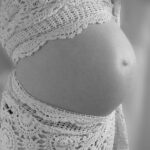When my doctor called to tell me that, at just shy of my 9 month point, I have preeclampsia and needed to come to the hospital right away, I didn’t really have any questions. We’d discussed the possibility for weeks, and I had done everything I knew to prevent it – which is to say, almost nothing. But for me, a mother who’d had three natural childbirths with few complications, the diagnosis of preeclampsia was frustrating to say the least.
What Preeclampsia Is
Of all late-term pregnancy complications, preeclampsia is probably the least understood. It’s a condition diagnosed in three to seven percent of pregnancies where the mother probably feels perfectly fine, but in which her body is having a severe reaction to the pregnancy that can kill her and her unborn baby in hours.
The condition seems to be related to the placenta. Something few people realize is that the placenta is an additional organ shared by the mother and the fetus. In most people, it behaves properly, filtering out dangers from the mother’s blood while it ensures the baby receives adequate nutrition. It’s miraculous in many ways, providing for the complex and demanding nutrition of the baby while cushioning the mother’s body from the shock of this foreign body.
In a few women, though, the placenta causes serious problems. One of those problems is gestational diabetes – another issue I have. In this complication, the previously-healthy mother develops a form of diabetes because the placenta interferes with her body’s proper use of insulin.
Preeclampsia is also caused by the placenta interfering with the mother’s body. It’s marked by elevated blood pressure greater than 140/90 and protein in the urine over a set level; though protein in the urine is normal for gestational diabetes, the tests my doctor had done clearly indicated preeclampsia. Left untreated, preeclampsia can lead to damage to the mother’s organs, including her liver and kidneys, and if it develops into eclampsia may even lead to convulsions and possibly the mother’s death. The baby is at risk primarily due to the deterioration of the uterus’s health. There is no cure for preeclampsia except the delivery of the baby, and no certain way to prevent it.
The Leadup To My Diagnosis
Preeclampsia was not a surprise. A week before the diagnosis, my doctor had tested my blood pressure and found it to be just a little high for me – 142/95, where I usually sit right around 125/85. He sent me straight up to the OB clinic for a nonstress test and ordered multiple other tests for blood and urine.
If your doctor fears preeclampsia, here’s what you can expect. The nonstress test consisted of two external monitors hooked up to my hugely pregnant belly – the same ones, if you’ve ever had a baby, that are normally used to monitor the baby’s heart rate and detect contractions. The medical staff are looking for a normal fetal heart rate of between 120 and 160, with at least two spikes within twenty minutes to ten beats or so over that normal rate. Often these will happen when you have a contraction; sometimes they occur when the baby shifts or kicks. This whole test is a means for determining whether the baby is in distress or not. In my case, little daughter Scarlett was her normal rambunctious self and passed with flying colors.
Also during the nonstress test, you will be hooked to a blood pressure monitor set to take your pressure every ten minutes. In my case, the nonstress test was done while I lay on my side because it was the only way to monitor the baby properly. The intern had my blood pressure cuff on the downhill arm. Simple physics tells you this is a mistake; I was registering in the 160s! After a nurse with considerably more experience and sense put it on the other arm, my pressure went down to a level that approached my normal blood pressure numbers.
Besides the nonstress test, the major diagnostic tool the doctor used was an unpleasant lab called a 24 hour urine specimen. This nasty thing was carried out by me taking home a milk-jug-sized plastic container and a urine catch tray similar in appearance to the hat worn by The Flying Nun. I had to collect all the urine I passed in a single day and bring it back to the lab, where it was tested for high protein levels. To those who have never been pregnant: try doing your urine catch when you wake up at 3 am bursting to get to the bathroom!
It was the urine test that ended my hopes for a relatively uncomplicated pregnancy and delivery; it clearly indicated too much protein in my urine, caused by damaged small blood vessels leaking tiny amounts of blood into the kidneys. This meant I had to rush about and get myself to the hospital right away.
Preeclampsia: A Description
The single thing that leads to preeclampsia is the mother’s sensitivity to several pregnancy hormones that cause her blood vessels to constrict more than they’re supposed to. As you might imagine, this sudden lack of blood flow can cause dozens of secondary problems, including major organ failure, convulsions, and placental abruption – early separation of the placenta from the uterine wall.
There are a dozen risk factors for preeclampsia, from the ordinary (age of mother) to the bizarre (father of the baby having had a previous partner with preeclampsia). No one is certain what the root cause of the disease is, or even if there is a single root cause. Though several groups of women are more prone to preeclampsia, any pregnant woman can develop it. Heightened risk is found in women who:
* Are going through a first pregnancy, or who are having a first pregnancy with a new partner
* Are overweight, especially obese women
* Have high blood pressure, kidney disease, lupus, or preexisting diabetes
* Are carrying two or more babies
* Have a family history of preeclampsia in close relatives
* Are younger than 20 or older than 40
Typically, preeclampsia develops in the later stages of pregnancy, but it has been noted as early as 16 weeks. Because the root cause of the disease is the placenta, the only cure for it is to remove the placenta and deliver the baby. This may be done if testing shows the baby is ready to come out, or if steroids can be administered to encourage the rapid maturation of the lungs so the baby can be safely delivered a few days after the mother’s admission to the hospital.
Preeclampsia Prevention and/or Treatment
Doctors say there is no way to prevent preeclampsia, and only a few ways to treat it short of total hospitalization.
The first recommendation is complete bed rest, feet up, for the mother. In very mild and uncomplicated cases, this can be done at home if the mother can be monitored carefully; in more complicated cases, such as mine, the mother will be admitted to the hospital. As long as the disease does not progress – that is, blood pressure and urine protein levels remain stable and other symptoms like upper gastric pain, visual disturbances, and headaches don’t appear – the mother can simply wait for the baby to mature naturally, then deliver him or her in the pre-planned way.
The other recommendation, for those in whom other complications get in the way, is admission to the hospital, administration of steroids to mature the baby more rapidly, and labor induction.
Mothers with preeclampsia may have a few other ways to treat the disease. There is some evidence that a special diet can help with certain symptoms, and when combined with complete bed rest at home may allow the mother to remain stable until the baby is delivered. More controversial is the use of drugs to help dilate the blood vessels and/or lower blood pressure.
There is some evidence, though very controversial, that there are some ways to decrease the risk of preeclampsia apart from minimizing the above risk factors.
A few years ago, a doctor was doing a sexual practices survey among high-risk women looking for anything that might predispose women to pregnancy complications. What he found was startling. In women with preeclampsia, when controlled for other factors like age, far fewer reported engaging in oral sex. In women who did not have preeclampsia, oral sex was as much as fifty percent more common.
Couldn’t possibly be, other researchers said, and they performed their own surveys. Result after result, the numbers remained stable. Women who engage in oral sex are less likely to have preeclampsia, and other diseases that may be related to the rejection of the placenta are also decreased. Also, a woman who has frequent sex with the father of the baby is protected as well, though to a lesser extent.
The theory is that ingesting or exposure to the genetic material of the father of a baby primes a woman’s immune system to accept that material when a baby is conceived. This matches well with the evidence that a man whose previous partner had preeclampsia is more likely to have later partners with preeclampsia. Blame the man for this one too! (though if you practice preeclampsia prevention, he probably will happily take the blame.)
What It’s Like To Have Preeclampsia
Imagine this: you feel perfectly fine. You may even feel energetic. But the doctor tells you that you must come down right away; that they must do a dozen tests on you and your baby, and – the kicker – it’s likely that you will be admitted to the hospital for observation until the day the baby is born.
That’s where I am right now. Yesterday I was hooked up to a machine multiple times, had my blood pressure taken multiple times, got to pee in a cup, was treated by at least four doctors and about the same number of nurses, and was not allowed to eat for seven hours even though I’m gestationally diabetic. (The eating issue is a whole nother rant.) If I didn’t feel bad before I got to the hospital, I sure did by the end of the day!
Besides all this, they gave me an amniocentesis, hoping that the baby was done enough to just be induced. She’s not. She is about six pounds now, but her lungs – the critical factor – aren’t quite ready. Ready or not, though, the amnio brought on contractions stronger than any I’d had up to this point, which worried the staff until they stopped – after I got to eat and walk around for a moment. Common sense! My body thought it was in distress and tried to bring the baby on out. Sigh.
So now I’m sitting in a hospital bed with a gown open down the back, a needle in the back of my left arm, typing at 5 am because sleep and hospitals don’t really go hand in hand for me. My husband, who stayed faithfully and helplessly at my side all day, went home to care for our younger two boys, though he’ll be back in the morning.
Considering that, besides the needle, I don’t feel any worse than I did yesterday, last week, or last month, the situation is frustrating to say the least. The doctor implies that he MIGHT let me go home, but no promises. I think I’m stuck here until I go home with a baby.
NOTE: The doctors released me the day after they admitted me because every indication was that I’m doing fine. But I have biweekly appointments, have been given bedrest, and have been warned that I could be readmitted until birth if there is any indication that either Scarlett or I am at risk.
** The fear of preeclampsia is not a good reason to forgo natural or even home childbirth methods. Read Heather B.’s excellent article on how home birth experts deal with preeclampsia and other complications in pregnancy.




